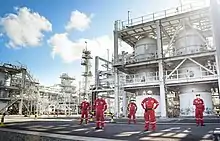Malampaya gas field
The Malampaya gas field or the Malampaya-Camago field is a deepwater gas-condensate reservoir, located in the Service Contract 38 license area, located offshore, 65 km northwest of the island of Palawan, Philippines.
| Malampaya Gas Field | |
|---|---|
| Country | Philippines |
| Region | West Philippine Sea |
| Location | Northwest Palawan |
| Block | SC 38 |
| Offshore/onshore | offshore |
| Operator | Shell Philippines Exploration B.V. |
| Partners | Chevron Malampaya LLC, PNOC-EC |
| Field history | |
| Discovery | 1989 |
| Start of development | 1997 |
| Start of production | 2001 Phase 1 Project Director = David J Greer OBE FIMechE |
| Production | |
| Producing formations | Nido Formation |
Background

The field was discovered during the drilling of the Camago-1 well in 1989, and following successful appraisal of the Malampaya field in the 1990s, first gas flowed in September 2001. Commercial production started in January 2002. The field was developed and currently operated by Shell Philippines Exploration B.V. (SPEX), under the Royal Dutch Shell; with joint venture partners - Chevron Malampaya LLC and Philippine National Oil Company Exploration Corporation. On November 13 2019, the Dennis Uy-led Udenna Corp. acquired Chevron Philippines Ltd.’s 45% stake.[2][3]
The Malampaya Phase 1 development included five production wells, tied back via flowlines to the Shallow Water Platform. Gas is exported through a 504-km subsea Gas Export Pipeline that delivers to the Onshore Gas Plant in Batangas, Luzon Island, for the final treatment and metering.
Shell successfully completed Malampaya Phase 2 in 2013, which added two new production wells. Malampaya Phase 3 saw the design, fabrication and installation of a new depletion compression platform to maintain levels of gas production, which began operating in October 2015. This was the first oil and gas platform to be designed and built in the Philippines, and its successful completion has made the country a player in construction for the oil and gas industry.
The upstream component of the US$4.5 billion Malampaya gas-to-power project was expected to provide substantial long-term revenue of between $8 billion–$10 billion to the Philippine government over its life span. As of 2018, the project has already surpassed US$10 billion in government revenues. Malampaya is benefiting the Philippines in countless ways, including reducing oil imports, assuring a more stable supply of energy and a cleaner source of power, and meeting up to ~40% of Luzon's energy requirements. The operation of Malampaya in the power stations’ full capacity of 3,200 megawatts is displacing over 1.35 million kilograms of CO2 per hour–a cleaner and more sustainable process, as compared to energy generation using coal or fuel oil.[4]
Key Facts
Location: Offshore Palawan, Philippines
Depth: Wells are in 820 metres (2,690 feet) of water depth and the reservoir is 2,990 metres below sea level
Interests: Shell Philippines Exploration B.V. 45% (Shell-operated), Chevron 45%, Philippine National Oil Corporation-Exploration Corporation (government) 10%
Key contractors: Malampaya is a joint undertaking of the Philippine national government and the private sector. The project is spearheaded by the Philippine Department of Energy (DOE) and developed and operated by Shell Philippines Exploration B.V. (SPEX) on behalf of joint venture partners Chevron Malampaya LLC and the Philippine National Oil Corporation-Exploration Corporation
Fields: Camago-Malampaya gas reservoir
Production (100%):
- about 429 million cubic feet per day (12.1 million cubic metres per day) gas production at standard conditions
- about 15 thousand barrels (2,400 m3) per day condensate[5]
Malampaya fund scam
The Malampaya Fund is a government fund that was allegedly plundered in 2009. The Malampaya Fund, profits from the Malampaya Deep Water Gas-to-Power project, was created to support energy resource development and exploration programs, with the Philippine president given the prerogative to determine other uses for the profits.[6]
In 2009, then-president Gloria Macapagal Arroyo authorized then-budget secretary Rolando Andaya Jr. to release PHP900 million from the fund to aid victims of Tropical Storm Ondoy and Typhoon Pepeng.[7][8] The amount did not go to the communities affected by the disasters but was allegedly plundered after being released to nongovernmental organizations linked to Janet Lim Napoles.[9][8][6]
Andaya and Napoles were subsequently charged for allegedly violating the Anti-Graft and Corrupt Practices Act.[10]
See also
References
- https://www.philstar.com/headlines/2019/11/13/1968478/dennis-uys-udenna-corp-acquires-chevrons-45-malampaya-stake
- Rivas, Ralf (November 13, 2019). "Dennis Uy now owns almost half of Malampaya gas field". Rappler. Retrieved 2020-02-25.
- Lucas, Daxim L. (November 13, 2019). "Duterte backer, trader Dennis Uy, buys nearly half of Malampaya". Inquirer. Retrieved 2020-02-25.
- http://malampaya.com/
- "Shell.com". Retrieved December 10, 2019.
- Buan, Lian (November 6, 2017). "How the P38-billion Malampaya fund was misused". Rappler. Retrieved 2020-02-25.
- Rappler.com. "Napoles, ex-officials to be arraigned over Malampaya scam". Rappler. Retrieved 2020-02-25.
- Bacungan, VJ (December 8, 2017). "Ombudsman charges 25 individuals for P900 million Malampaya Fund scam". CNN. Retrieved 2020-02-25.
- Rufo, Aries (September 20, 2013). "How the Malampaya fund was plundered". Rappler. Retrieved 2020-02-25.
- Chiu, Patricia Denise M. (April 23, 2019). "Napoles refuses to enter plea in Malampaya Fund scam case". Inquirer. Retrieved 2020-02-25.